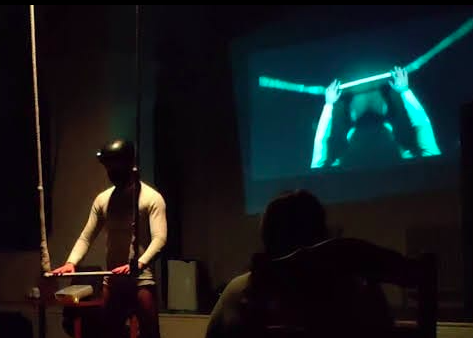Review from: NoFit State Circus, Four Elms, Cardiff; 30th July 2021
How does a swinging trapeze artist continue working in a global pandemic? In smaller spaces, in emptier spaces, in digital spaces, in the spaces around and outside of their usual physical tricks…This new show by Eric McGill is both documentation and evidence of the way his work and his relationship with audiences have developed over the last year and a half. The ghost of Covid-19 – as with ghosts of McGill’s previous performances, physical histories and personal connections – is ever present in The Denial This is Forever. I want to punctuate the title with a colon, but that’s not how it’s written, leaving an ambiguity to its intended meaning that feels in keeping with our current state of unknowing regarding the future. In fact the whole show is suffused with ambiguity, but not the annoying, unthinking kind. The kind of ambiguity that comes with being human: morality; time; experience; relations.
Promoted as ‘part museum, part live action video game, part live performance’, the show has been created especially to fit the spaces of NoFit State Circus‘ Four Elms building. In the parlour, a digital diary of video call clips and filmed physical work populate the centre’s designated social space; a corridor we move along is observed at a safe digital distance through projected imagery; in the small training room we’re invited – digitally – to imagine our own bodies moving through an aerial routine; in the larger space, more accustomed to performance, we watch the same routine on a real life low hanging static trapeze over a fat crashmat, and on a large screen behind, in time yet out of it. We feel the disorientation of a live first-person VR projection, and we watch a physical artist sitting at a computer, drinking a cup of tea. Working digitally, one could presume.
The show pushes and pulls between opposing paradigms, appropriately enough for the work of a swinging artist. The informal, confessional tone of social media dialogue is broadcast at a distance and through screens to strangers. The warm intimacy of a candlelit path is created with plastic and an electric glow. The boundaries between obedience and autonomy are confused. I chuckle out loud, on my own, behind my mask, at silly things placed like easter eggs in an open world RPG, and I sit with tears streaming down my face as I sit in the audience munching from a bag of popcorn. So far, so 2021.
There is an archival element both in the show’s materiality and in its message. Our lives are constructed from the traces of what we have undergone before. A page explaining the term ‘liminal‘ is displayed on the wall. ‘Palimpsest‘ would also have been a good fit. I wonder how I would have experienced the audio instruction section differently if I hadn’t physically executed some of the described movements in my own past. Now I’m reading back the notes I scribbled when I got home after the show, and I don’t know if I meant it literally or metaphorically when I wrote that it asks ‘What have we learnt from this?’ I know the question seemed apt simultaneously for the pandemic, the show, or a lifetime.
Unlike most circus performers, Eric had already been exploring the possibilities for digital circus and audience experience before the pandemic hit, which is perhaps why this show feels much more satisfying than many of the sudden online offerings that have abounded over the last year. Nonetheless, choosing a medium and having circumstances force it upon you are two different things. The final live trapeze choreography we see is a moving picture of waiting – smooth transitions through strange sedentary holds, gracefully expressing the blend of frustration and acceptance that so many of us are familiar with under covid restrictions – accompanied by a beautiful piano composition by Eric’s dad. (Both Eric’s parents appear, digitally, in this show). The music begins elegiac but ends in more upbeat, hopeful tones. This pandemic will remain with us as a physical and psychological memory, but the days it will stay dangerously pathological must be numbered. Trapezes will swing above thrilled crowds again. A further hope, though, is that the doors have also been opened for more thoughtful multimedia circus work of this kind.




